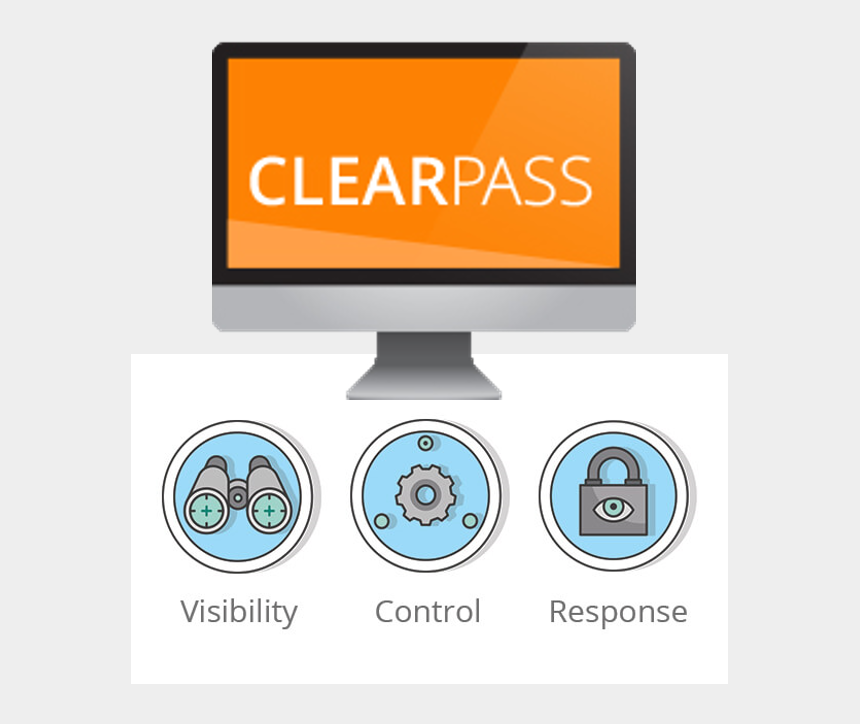The Importance of a NAC solution - Aruba ClearPass
In today's rapidly evolving digital landscape, organizations face unprecedented challenges in securing their networks and data. The proliferation of mobile devices, the rise of remote work, and the increasing sophistication of cyber threats have made traditional perimeter-based security models inadequate. As organizations embrace more complex IT environments, with a mix of on-premises, cloud-based, and hybrid infrastructures, there is a growing need for robust and flexible network access control solutions. Aruba ClearPass emerges as a vital solution in this context, offering comprehensive security and access management capabilities that help organizations secure their networks while providing seamless access to authorized users.
Overview of Aruba ClearPass
Aruba ClearPass is a leading network access control (NAC) solution that provides organizations with granular control over who and what devices can access their networks. Unlike traditional NAC solutions that rely heavily on static policies and limited visibility, ClearPass leverages dynamic policies, comprehensive device profiling, and user identity management to offer a more adaptive and secure approach to network access.
ClearPass is designed to integrate with a wide array of network infrastructure components, including wired and wireless networks, VPNs, and firewalls. This integration enables organizations to enforce consistent access policies across all points of entry into the network, ensuring that only authorized users and devices can connect to critical resources. Additionally, ClearPass supports a broad range of authentication methods, including 802.1X, RADIUS, TACACS+, and more, providing flexibility in how organizations authenticate and authorize users and devices.
The Role of Identity in Securing the Modern Workplace
The modern workplace is characterized by a diverse and dynamic mix of users, devices, and applications. Employees, contractors, and guests regularly access corporate networks from various locations and devices, including laptops, smartphones, tablets, and IoT devices. This diversity presents a significant challenge for IT and security teams, who must ensure that only authorized users and devices can access sensitive data and resources.
Identity plays a crucial role in addressing this challenge. By tying network access to user identity, organizations can enforce more granular and context-aware access policies. For example, a user’s access to specific resources can be restricted based on their role within the organization, the type of device they are using, and even their location. This approach allows organizations to move beyond the traditional perimeter-based security model, where access is granted based solely on network location, to a more sophisticated model that takes into account the user's identity and context.
How Aruba ClearPass Integrates with Devices and Services
Aruba ClearPass is designed to integrate seamlessly with a wide range of devices and services, making it a versatile solution for securing network access in diverse IT environments. The following sections explore how ClearPass integrates with various components of an organization's infrastructure:
1. Integration with Network Infrastructure
Aruba ClearPass integrates with network infrastructure components, such as switches, routers, wireless access points, and VPN gateways, to enforce access policies at the point of entry. This integration is achieved through industry-standard protocols like RADIUS, TACACS+, and 802.1X, allowing ClearPass to authenticate and authorize users and devices before granting network access.
For instance, when a user attempts to connect to the corporate Wi-Fi, the access point sends a request to the ClearPass server, which then checks the user's credentials against a directory service, such as Active Directory or LDAP. If the user is authorized, ClearPass allows the connection and applies the appropriate access policies based on the user's identity, device type, and other contextual factors.
2. Device Profiling and Endpoint Visibility
ClearPass provides advanced device profiling capabilities, allowing organizations to gain visibility into all devices connected to the network. It can identify and classify devices based on various attributes, such as the device's operating system, manufacturer, and hardware characteristics. This information is critical for enforcing access policies tailored to specific device types.
For example, ClearPass can automatically detect and classify IoT devices, such as printers, security cameras, and industrial sensors, which often require different access privileges than traditional computing devices. By profiling devices, ClearPass ensures that only authorized devices can connect to the network, reducing the risk of unauthorized access or compromised devices.
3. Integration with Identity and Access Management (IAM) Systems
ClearPass integrates with various identity and access management (IAM) systems, such as Microsoft Active Directory, LDAP, and Azure AD, to streamline user authentication and authorization. This integration enables organizations to leverage existing user directories to enforce consistent access policies across the network.
ClearPass can also integrate with multifactor authentication (MFA) solutions to enhance security further. For example, when a user attempts to access sensitive resources, ClearPass can require them to authenticate using a second factor, such as a one-time passcode sent to their mobile device. This additional layer of security helps protect against credential theft and unauthorized access.
4. Integration with Security Information and Event Management (SIEM) Systems
ClearPass can feed network access logs and security events into Security Information and Event Management (SIEM) systems for centralized monitoring and analysis. This integration allows security teams to correlate access events with other security data, helping them detect and respond to potential threats more quickly.
For example, if ClearPass detects unusual access patterns, such as a user attempting to connect from multiple locations simultaneously, it can trigger an alert in the SIEM system. Security teams can then investigate the incident and take appropriate action, such as blocking the user's access or initiating an incident response.
5. Integration with Cloud Services
As organizations increasingly adopt cloud services, the need to secure access to these services becomes paramount. Aruba ClearPass integrates with cloud-based applications and services, such as Microsoft Office 365, Google Workspace, and AWS, to enforce consistent access policies across both on-premises and cloud environments.
ClearPass can use federated authentication protocols, such as SAML and OAuth, to authenticate users accessing cloud services. This integration allows organizations to apply the same identity-based access controls to cloud resources as they do to on-premises resources, ensuring a unified security posture across the entire IT environment.
6. Enhancing Security with Role-Based Access Control (RBAC) and Context-Aware Policies
One of the key strengths of ClearPass is its ability to enforce role-based access control (RBAC) and context-aware policies. RBAC allows organizations to define access rights based on the user's role within the organization. For example, an employee in the HR department may have access to payroll systems, while an IT administrator may have access to network management tools. By assigning roles and associated access privileges, organizations can ensure that users only have access to the resources they need to perform their jobs.
Context-aware policies take this a step further by considering additional factors, such as the user's location, the type of device they are using, and the time of day. For instance, an employee accessing the network from a corporate office may have broader access privileges than when accessing the network remotely from a personal device. By incorporating contextual information into access decisions, ClearPass helps organizations reduce the risk of unauthorized access and data breaches.
Use Cases and Benefits of Aruba ClearPass
Aruba ClearPass offers a wide range of use cases and benefits for organizations of all sizes. Some of the most notable use cases include:
1. Securing BYOD (Bring Your Own Device) Environments
With the rise of BYOD, employees increasingly use personal devices to access corporate networks and data. While BYOD offers flexibility and convenience, it also introduces security risks, as personal devices may not adhere to the same security standards as corporate-issued devices.
ClearPass addresses this challenge by enabling organizations to enforce security policies on BYOD devices. For example, ClearPass can require users to install a security app or configure their devices with specific security settings before granting network access. Additionally, ClearPass can enforce network segmentation, ensuring that BYOD devices only have access to specific resources, such as email and internet browsing, while restricting access to more sensitive data.
2. Guest Access Management
Organizations often need to provide network access to guests, such as customers, partners, and contractors. However, granting guest access without proper controls can expose the network to security risks. ClearPass provides a robust guest access management solution, allowing organizations to offer secure and convenient network access to guests while maintaining control over who can connect to the network.
ClearPass enables organizations to create guest access portals where guests can register for network access. Once registered, guests are provided with temporary credentials that grant them access to specific network resources. ClearPass can also enforce time-based restrictions, ensuring that guest access is automatically revoked after a specified period.
3. IoT Security
The proliferation of IoT devices presents unique security challenges, as these devices often have limited security capabilities and may be vulnerable to attacks. ClearPass provides comprehensive visibility and control over IoT devices, allowing organizations to secure their IoT environments.
ClearPass can automatically detect and profile IoT devices, assigning them to specific device groups based on their characteristics. Organizations can then apply tailored access policies to each device group, ensuring that IoT devices only have access to the resources they need. Additionally, ClearPass can enforce network segmentation, isolating IoT devices from the rest of the network to reduce the risk of lateral movement in the event of a security breach.
Conclusion
In an era where the modern workplace is increasingly decentralized, and the threat landscape is constantly evolving, Aruba ClearPass stands out as a critical solution for securing network access and protecting sensitive data. By integrating seamlessly with a wide range of devices and services, ClearPass enables organizations to enforce identity-based access controls, ensuring that only authorized users and devices can access their networks. Through its advanced device profiling, context-aware policies, and robust integration capabilities, ClearPass helps organizations achieve a unified security posture across their entire IT environment. As organizations continue to navigate the complexities of the digital age, Aruba ClearPass will play an increasingly vital role in securing the modern workplace.


